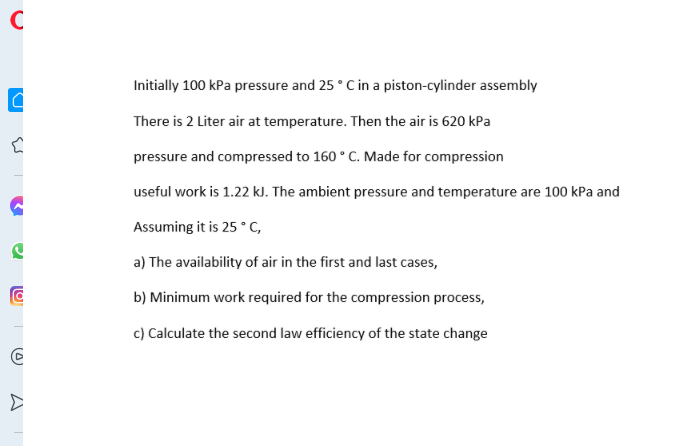A piston-cylinder assembly initially has 100 kPa pressure and 2 Liter air at 25 ° C. The air is then compressed to 620 kPa pressure and 160 ° C. Useful work for compression is 1.22 kJ. Assuming that the ambient pressure and temperature are 100 kPa and 25 ° C respectively, a) Calculate the availability of air in the initial and final states, b) the minimum work required for the compression process, c) Calculate the second law efficiency of the state change.
A piston-cylinder assembly initially has 100 kPa pressure and 2 Liter air at 25 ° C. The air is then compressed to 620 kPa pressure and 160 ° C. Useful work for compression is 1.22 kJ. Assuming that the ambient pressure and temperature are 100 kPa and 25 ° C respectively, a) Calculate the availability of air in the initial and final states, b) the minimum work required for the compression process, c) Calculate the second law efficiency of the state change.
Elements Of Electromagnetics
7th Edition
ISBN:9780190698614
Author:Sadiku, Matthew N. O.
Publisher:Sadiku, Matthew N. O.
ChapterMA: Math Assessment
Section: Chapter Questions
Problem 1.1MA
Related questions
Question
100%
A piston-cylinder assembly initially has 100 kPa pressure and 2 Liter air at 25 ° C. The air is then compressed to 620 kPa pressure and 160 ° C. Useful work for compression is 1.22 kJ. Assuming that the ambient pressure and temperature are 100 kPa and 25 ° C respectively,
a) Calculate the availability of air in the initial and final states,
b) the minimum work required for the compression process,
c) Calculate the second law efficiency of the state change.

Transcribed Image Text:C
Initially 100 kPa pressure and 25 °C in a piston-cylinder assembly
There is 2 Liter air at temperature. Then the air is 620 kPa
pressure and compressed to 160 ° C. Made for compression
useful work is 1.22 kJ. The ambient pressure and temperature are 100 kPa and
Assuming it is 25 ° C,
a) The availability of air in the first and last cases,
b) Minimum work required for the compression process,
c) Calculate the second law efficiency of the state change
(0)
Expert Solution
This question has been solved!
Explore an expertly crafted, step-by-step solution for a thorough understanding of key concepts.
Step by step
Solved in 2 steps with 1 images

Knowledge Booster
Learn more about
Need a deep-dive on the concept behind this application? Look no further. Learn more about this topic, mechanical-engineering and related others by exploring similar questions and additional content below.Recommended textbooks for you

Elements Of Electromagnetics
Mechanical Engineering
ISBN:
9780190698614
Author:
Sadiku, Matthew N. O.
Publisher:
Oxford University Press

Mechanics of Materials (10th Edition)
Mechanical Engineering
ISBN:
9780134319650
Author:
Russell C. Hibbeler
Publisher:
PEARSON

Thermodynamics: An Engineering Approach
Mechanical Engineering
ISBN:
9781259822674
Author:
Yunus A. Cengel Dr., Michael A. Boles
Publisher:
McGraw-Hill Education

Elements Of Electromagnetics
Mechanical Engineering
ISBN:
9780190698614
Author:
Sadiku, Matthew N. O.
Publisher:
Oxford University Press

Mechanics of Materials (10th Edition)
Mechanical Engineering
ISBN:
9780134319650
Author:
Russell C. Hibbeler
Publisher:
PEARSON

Thermodynamics: An Engineering Approach
Mechanical Engineering
ISBN:
9781259822674
Author:
Yunus A. Cengel Dr., Michael A. Boles
Publisher:
McGraw-Hill Education

Control Systems Engineering
Mechanical Engineering
ISBN:
9781118170519
Author:
Norman S. Nise
Publisher:
WILEY

Mechanics of Materials (MindTap Course List)
Mechanical Engineering
ISBN:
9781337093347
Author:
Barry J. Goodno, James M. Gere
Publisher:
Cengage Learning

Engineering Mechanics: Statics
Mechanical Engineering
ISBN:
9781118807330
Author:
James L. Meriam, L. G. Kraige, J. N. Bolton
Publisher:
WILEY